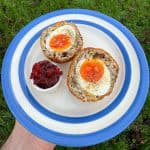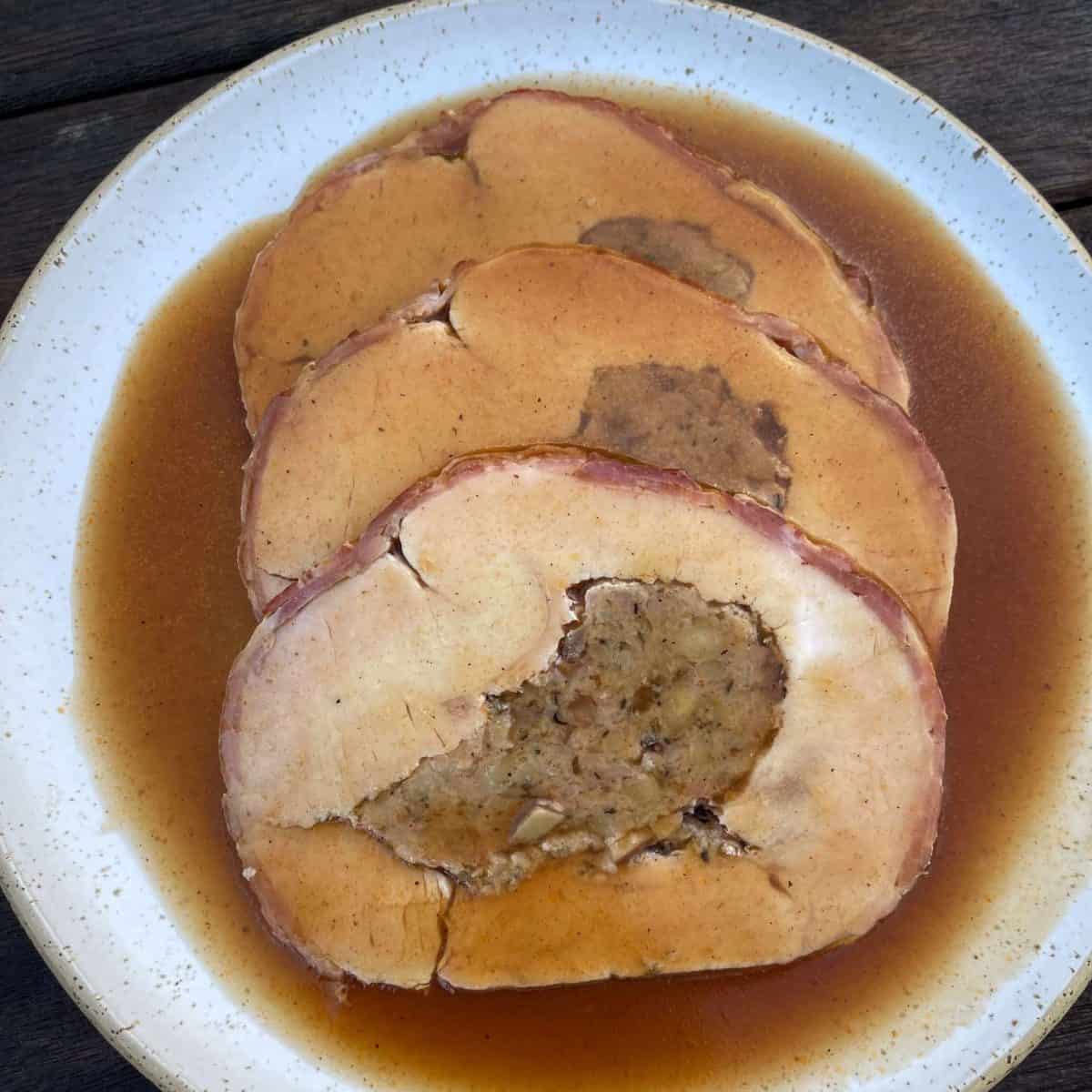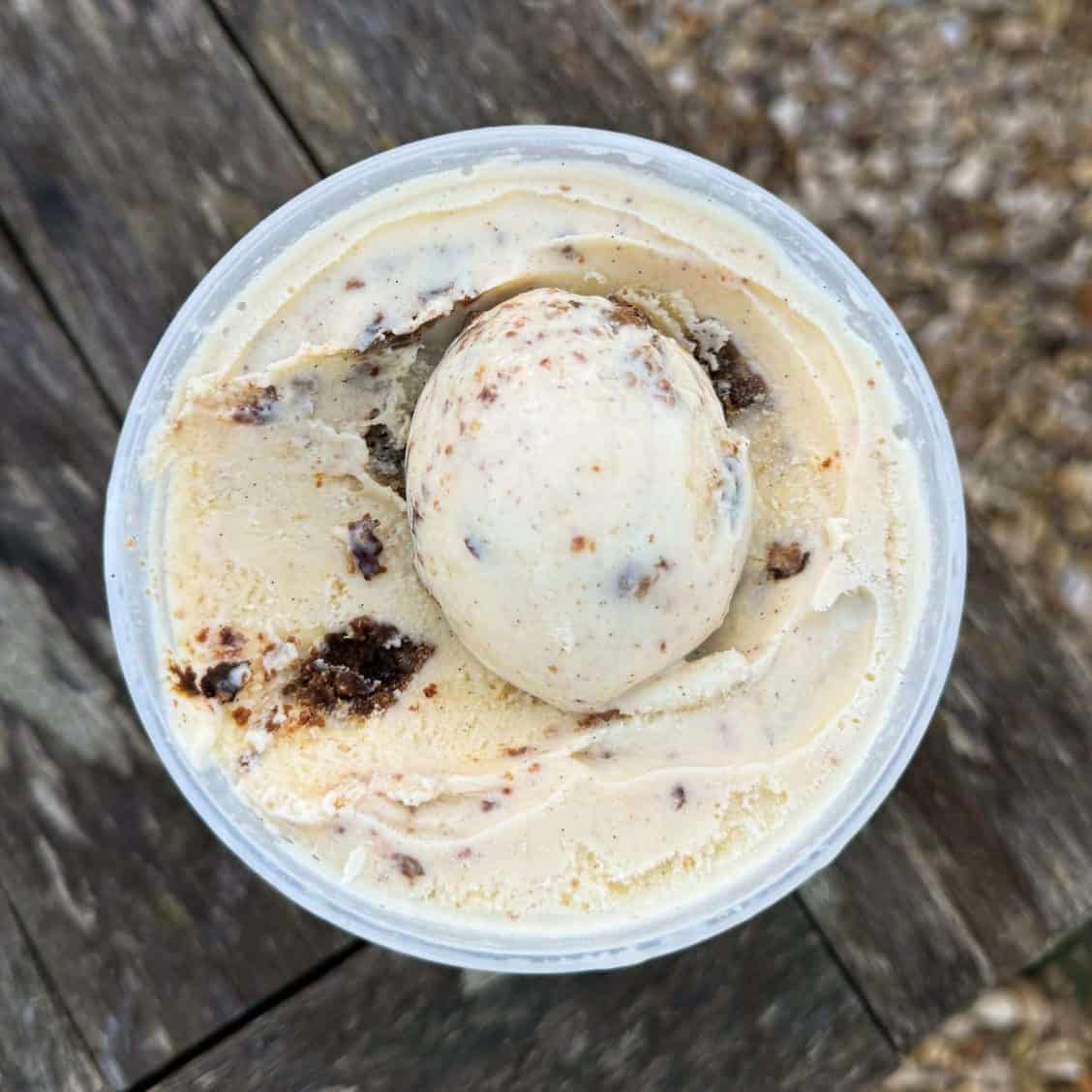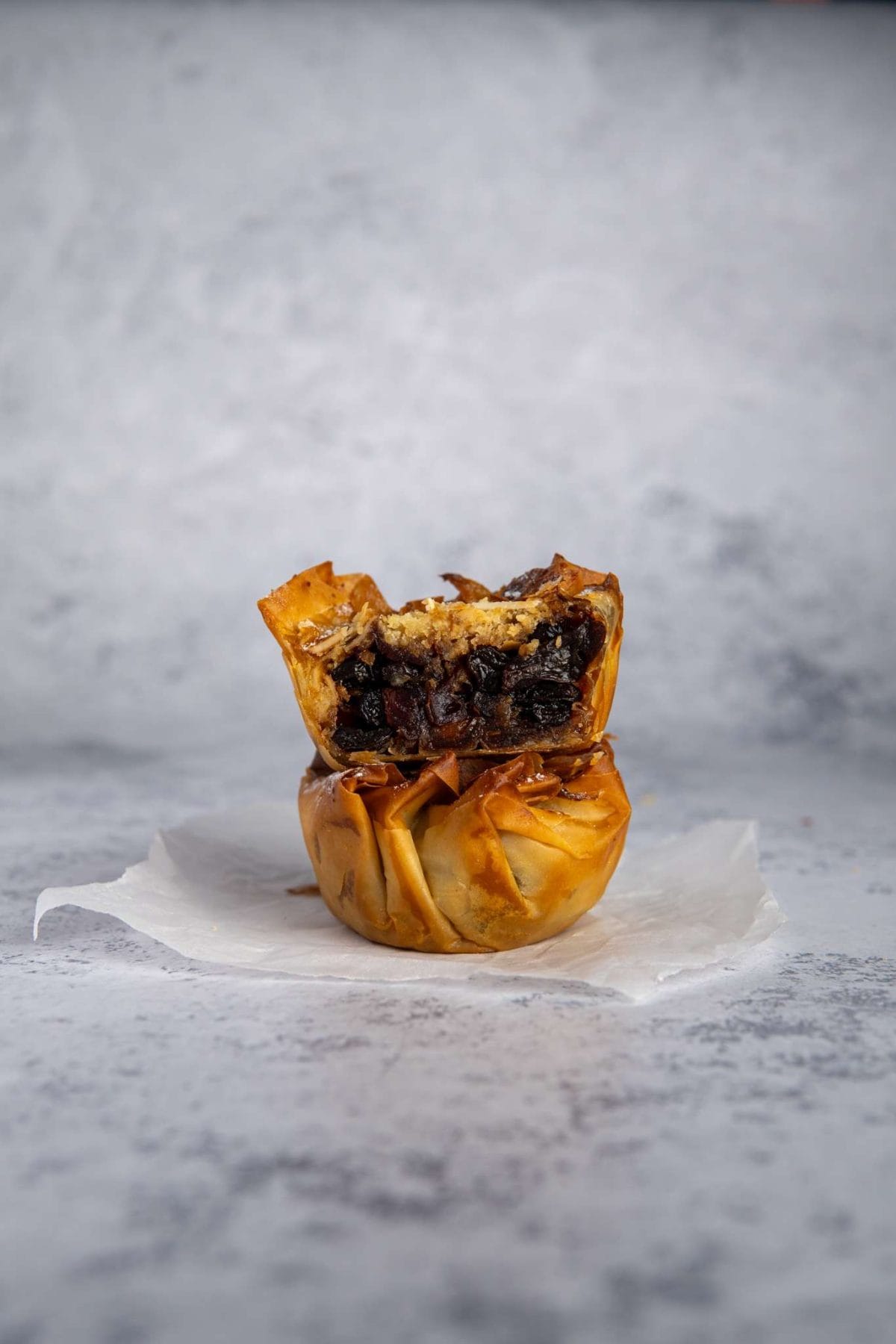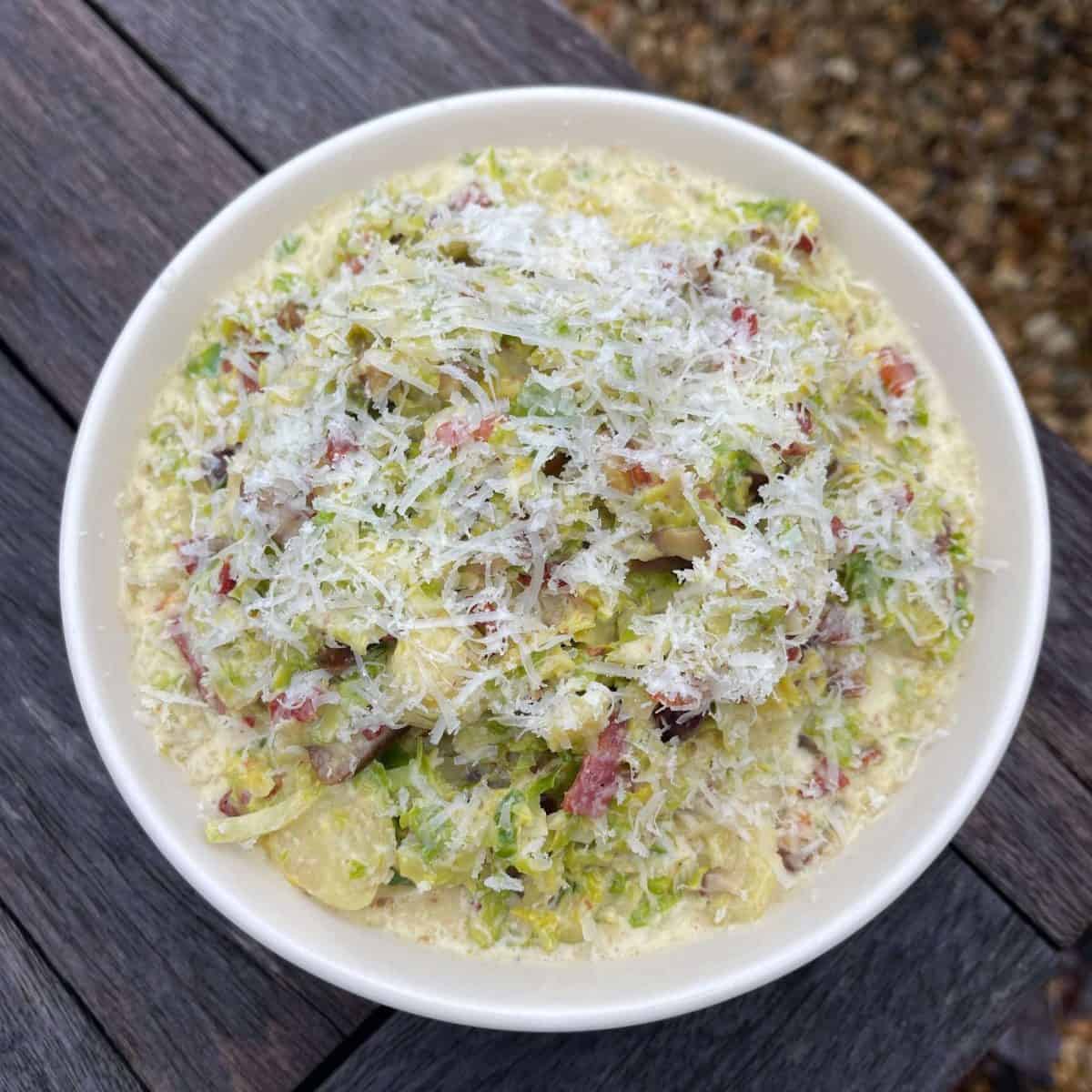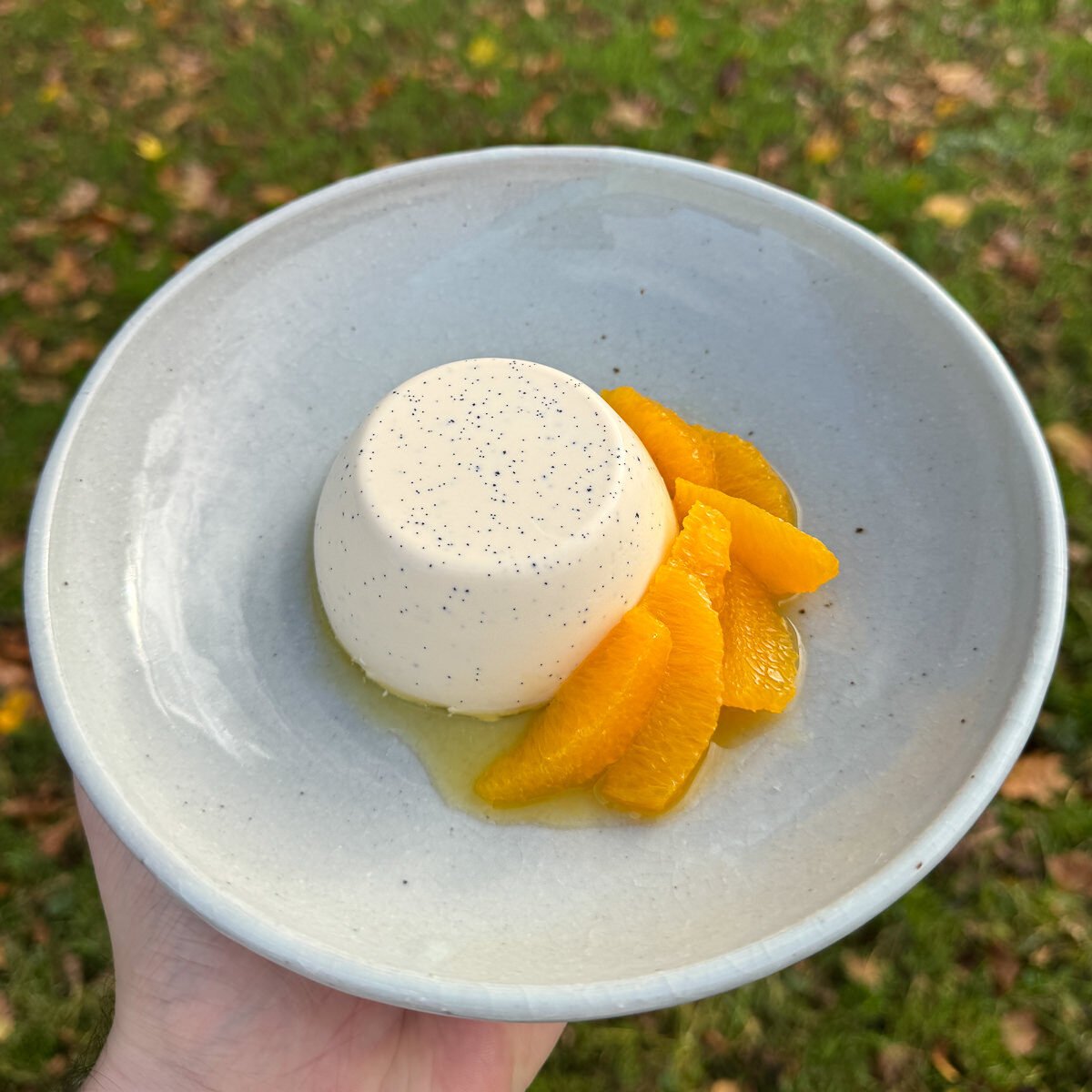Sage & Onion Christmas Scotch Eggs
These Christmas scotch eggs make a fantastic festive starter. There’s jammy soft boiled eggs, sage & onion sausage meat and the crispiest breadcrumb coating.
This post contains affiliate links.
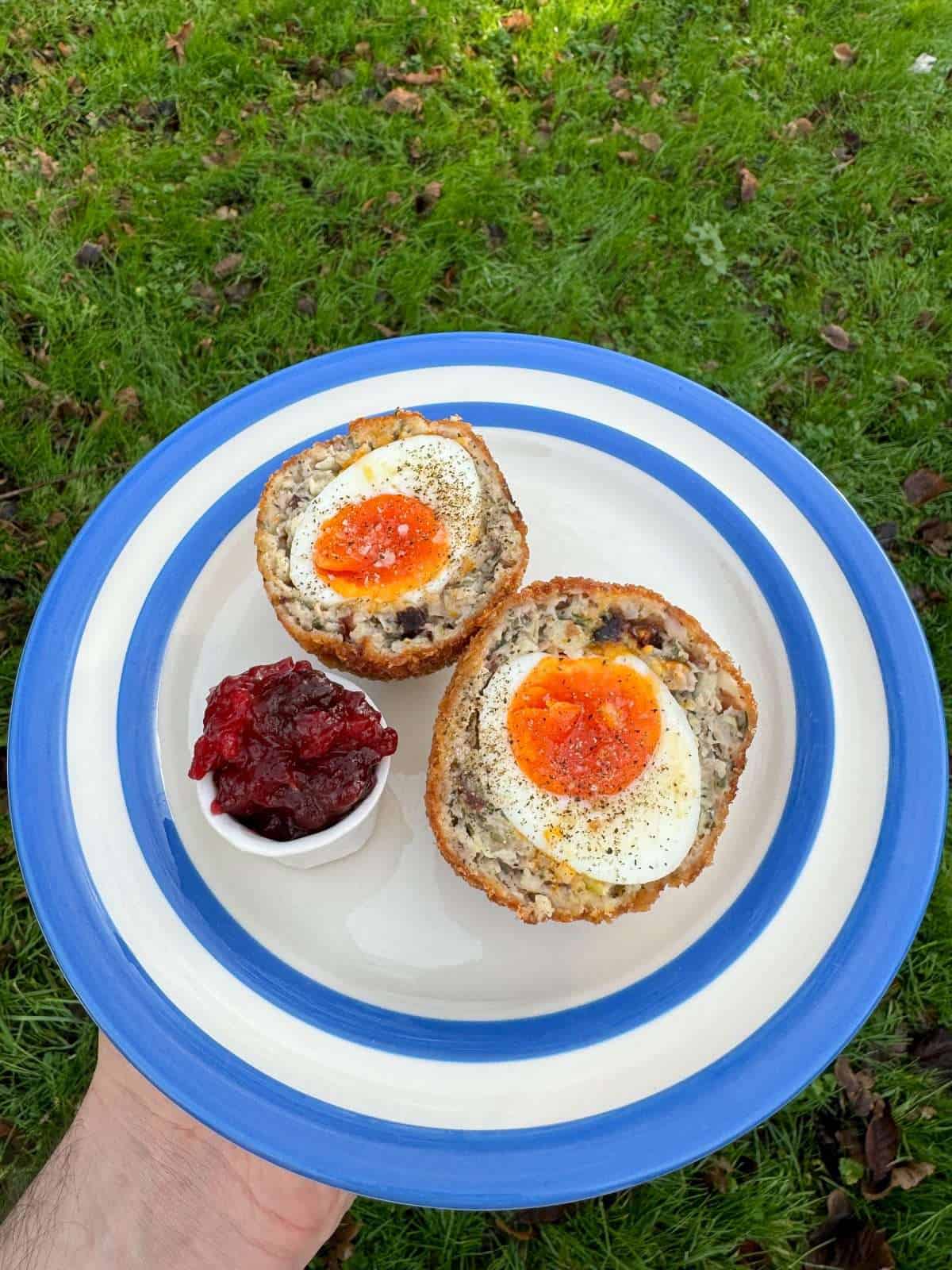
These sage & onion scotch eggs are a festive twist on the British pub classic!
Here, we’re wrapping squidgy soft boiled eggs in a homemade sage & onion sausage meat then coating them in panko breadcrumbs & deep frying them until crisp & golden. The yolks are fudgy & jammy, the sausage meat is full of flavour & the breadcrumb coating is crisp & crunchy. What’s not to like?
These festive scotch eggs pair fantastically with some homemade cranberry chutney (or sauce) and would make a great starter to serve on Christmas Day. They can be prepared a day in advance & they’re even good cold, so are ideal for prepping in advance.
For more snacks & starters take a look at our collection of appetizer recipes. Or something more festive, check out our collection of Christmas starters.
What Are Scotch Eggs?
Scotch eggs are a traditional British snack, where soft boiled eggs are wrapped in sausage meat, coated in breadcrumbs then deep fried until crispy. Scotch eggs are a popular pub & picnic dish and despite their name, actually originate from London, from Fortnum & Mason (the department store).
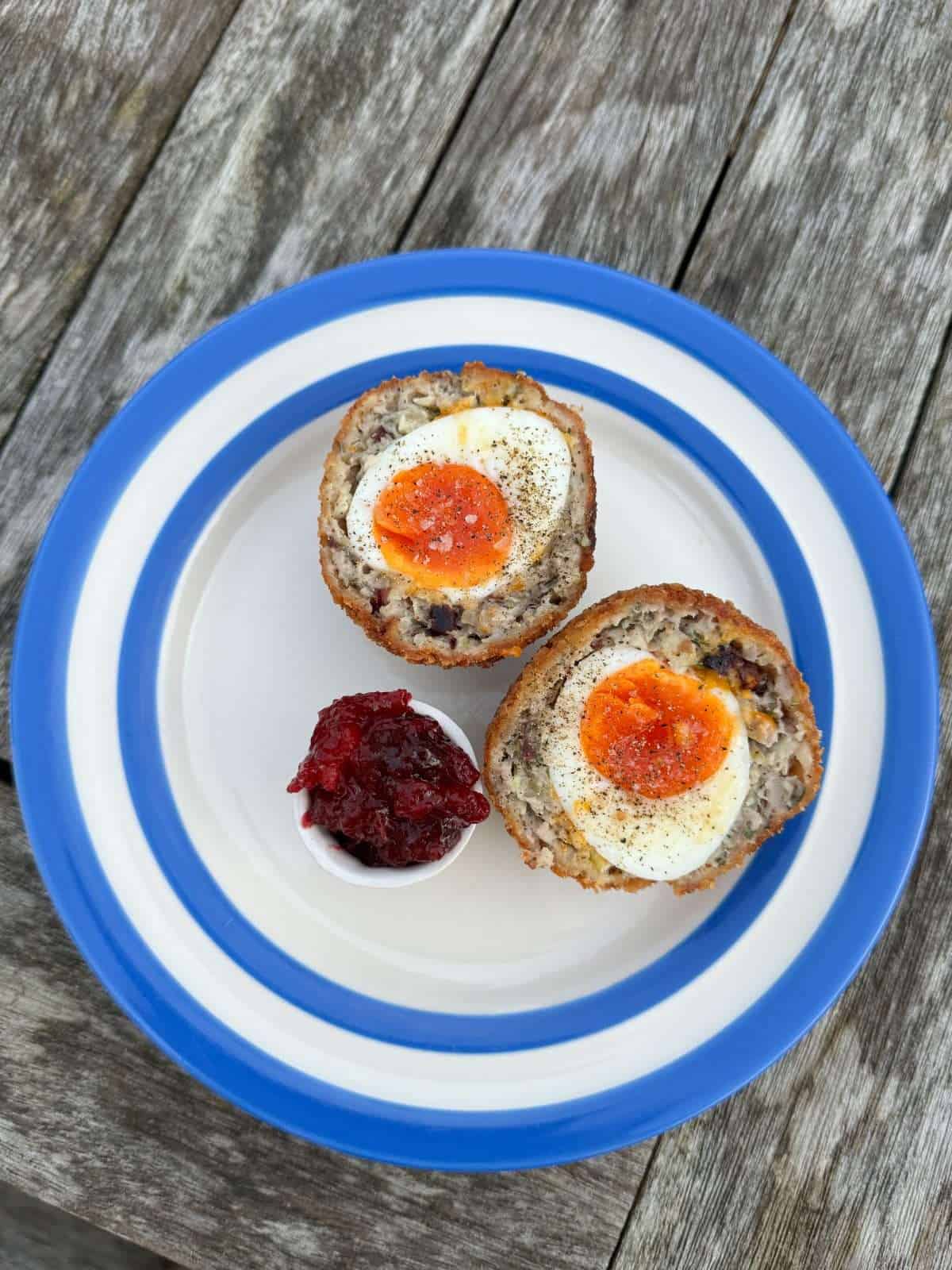
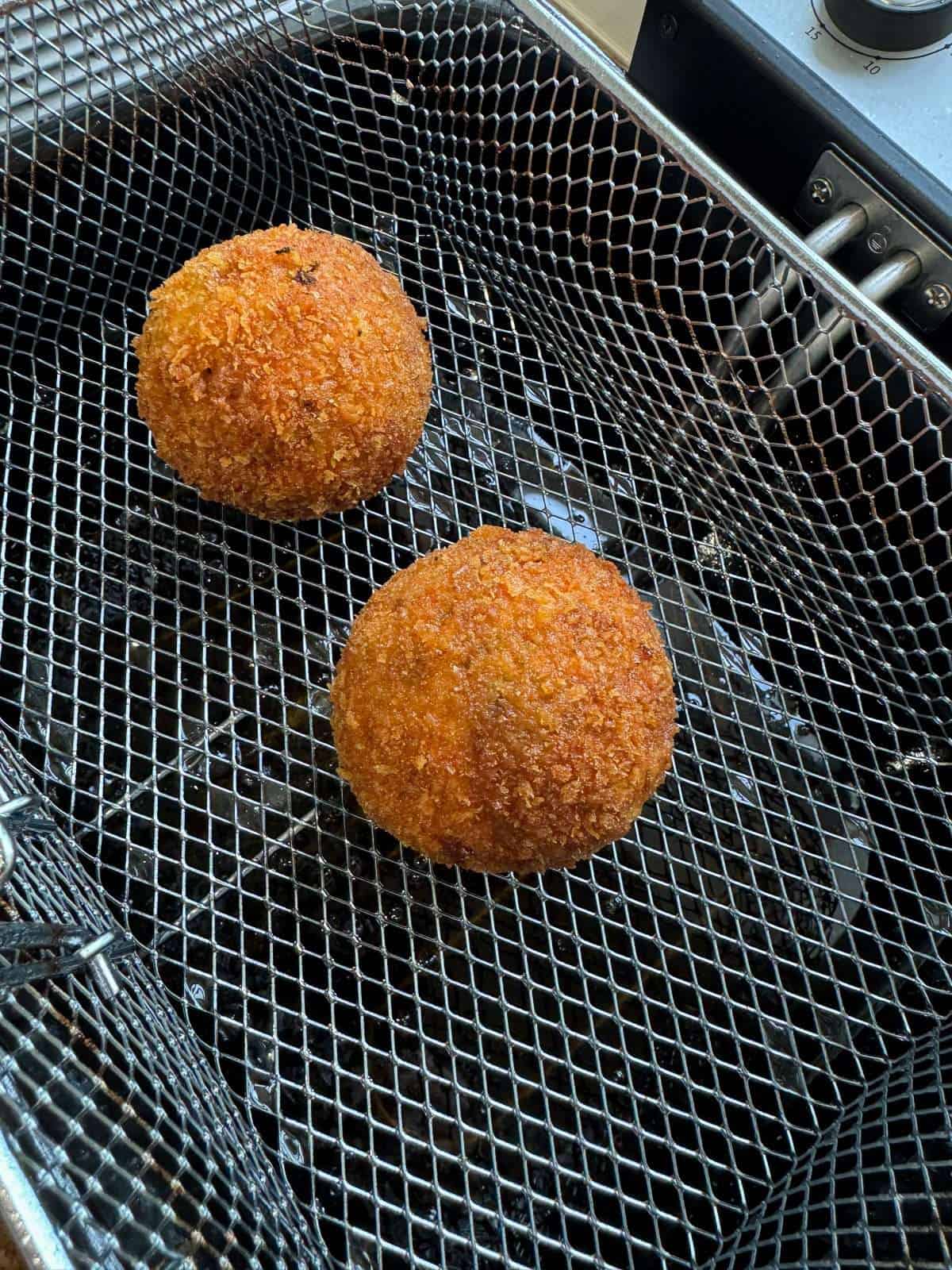
What You’ll Need
- Eggs – You’ll need large eggs for this recipe. When boiling eggs, it’s best to use ones that are slightly older, as these are easier to peel than fresh ones. You’ll also need eggs for bread crumbing the scotch eggs.
- Sausage Meat – Using a good quality sausage meat makes all the difference when making scotch eggs! I’d recommend visiting your local butchers.
- Onions – We’re adding fried brown onion to the sausage meat (like when you make stuffing!). White & red onions or shallots will work as well.
- Fresh Herbs – We’re flavouring the sausage meat with fresh thyme & sage.
- Apple – You’ll need one Granny Smith apple for this recipe. We’re going to be grating it (with the skin on) then adding into the sage & onion sausage meat.
- Dried Cranberries – I like to add dried cranberries into the sausage meat, for a festive twist! You’ll need to roughly chop these.
- Panko Breadcrumbs – These are Japanese breadcrumbs that are crispier than regular ones, once fried. You’ll find these in most supermarkets.
- Flour – You’ll need plain/all purpose flour for bread crumbing the scotch eggs.
How To Make Sage & Onion Christmas Scotch Eggs
The full, printable recipe card for these scotch eggs can be found at the bottom of this post! Here’s a quick rundown of the recipe…
Sage & Onion Sausage Meat
The sausage meat for these scotch eggs is inspired by a sage & onion stuffing. To make this, we fry diced onions until soft then once cool, mix with a really good quality sausage meat, grated apple, dried cranberries, fresh sage & thyme. Once mixed, we chill this in the fridge until needed.
To make our sausage meat as tasty as possible, I’d recommend frying a small amount of it in a frying pan, giving it a taste then adding in salt & pepper as needed.

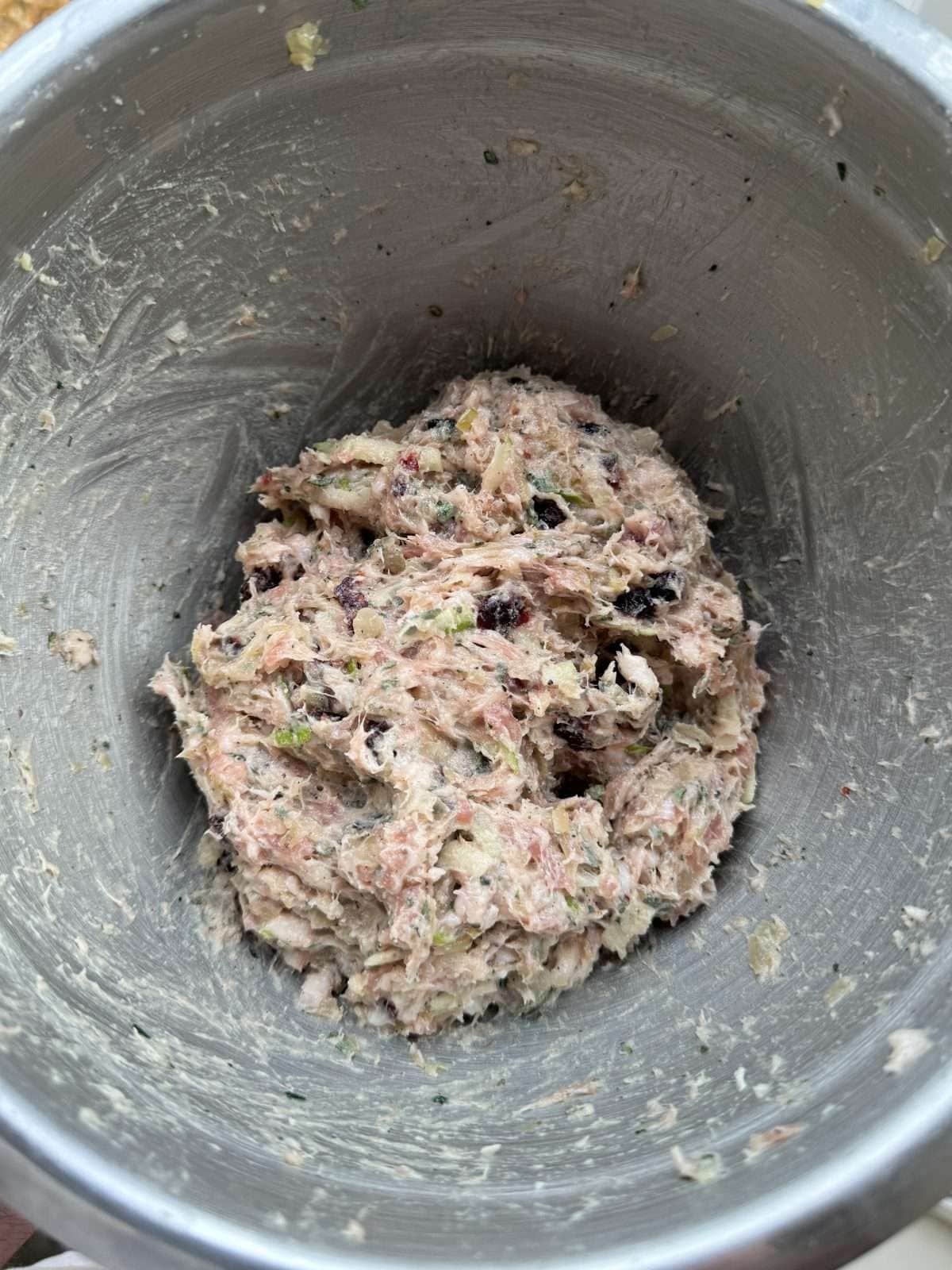
Soft Boiled Eggs
The key to making the best scotch eggs, starts with the cooking of the eggs. I like my eggs to be soft boiled, with fudgy, jammy yolks. To do this, we cook large eggs in boiling water for 7 minutes then immediately transfer into a bowl of ice & water, to cool down straight away.
Once completely cold, we peel the eggs then place them onto a plate lined with kitchen paper so that they can dry slightly before we assembly the scotch eggs.
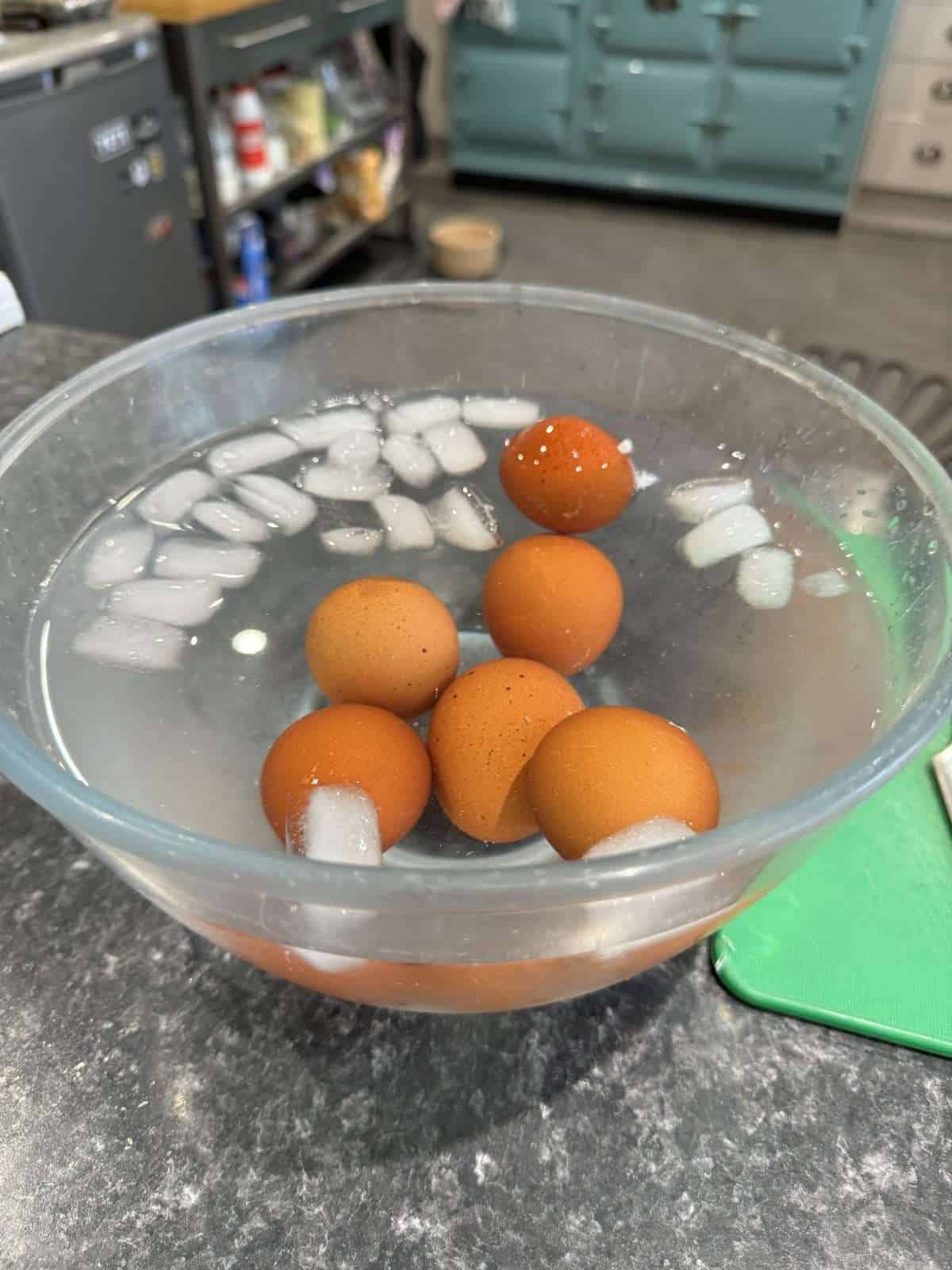
Assembly
When assembling our scotch eggs, it’s important that we wrap each egg in a layer of sausage meat that’s the same thickness all the way round. This way, the meat will cook evenly. Once assembled, it’s best to let the scotch eggs chill in the fridge for at least 30 minutes, so that they can firm up slightly. This makes them easier to handle.
To assemble a scotch egg, we take 90 grams of sausage meat, flatten it into a 5mm thick disc & place a boiled egg in the middle. Next, we mould the sausage meat around the egg, making sure that it is an even thickness all the way round.
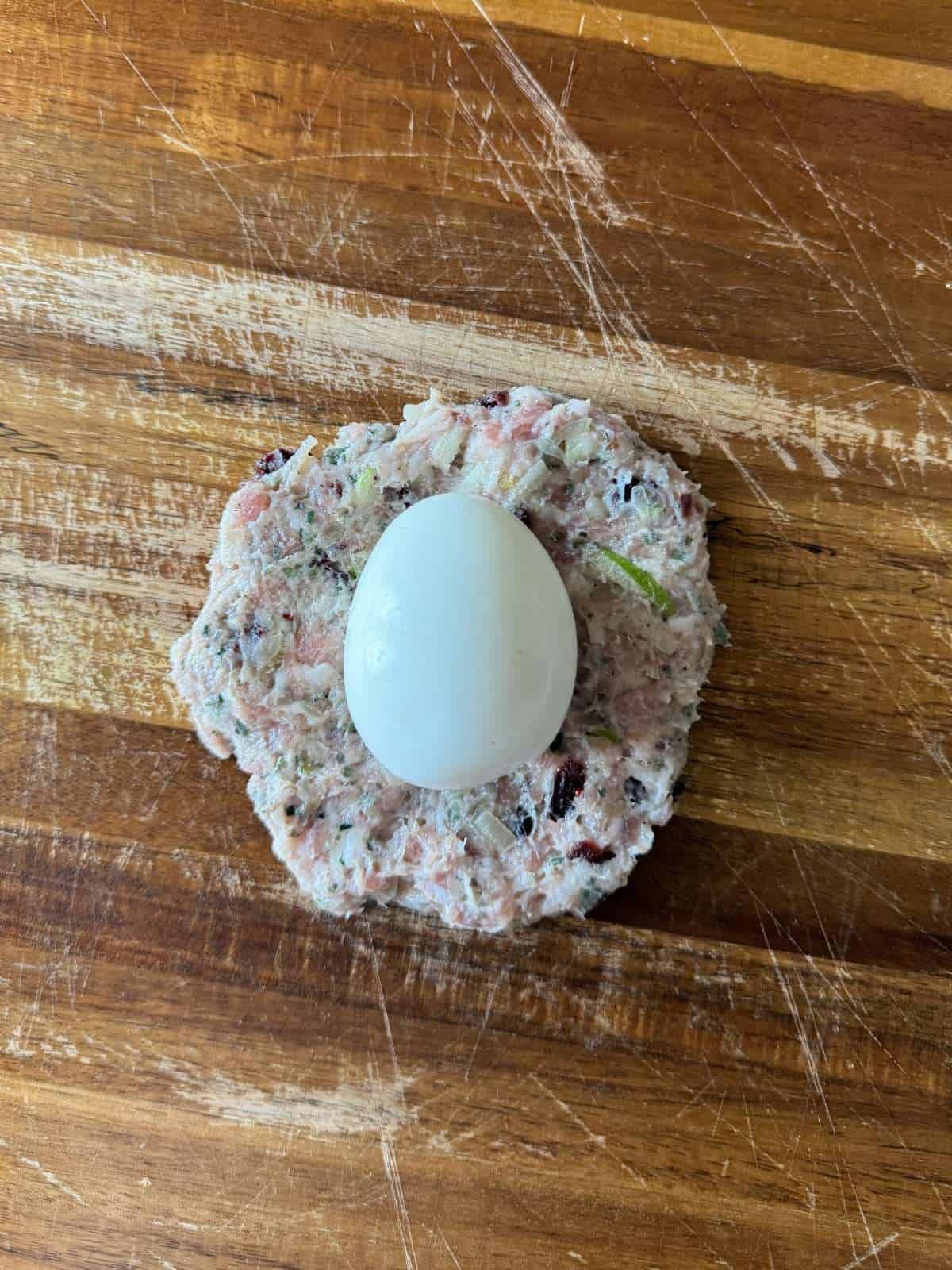
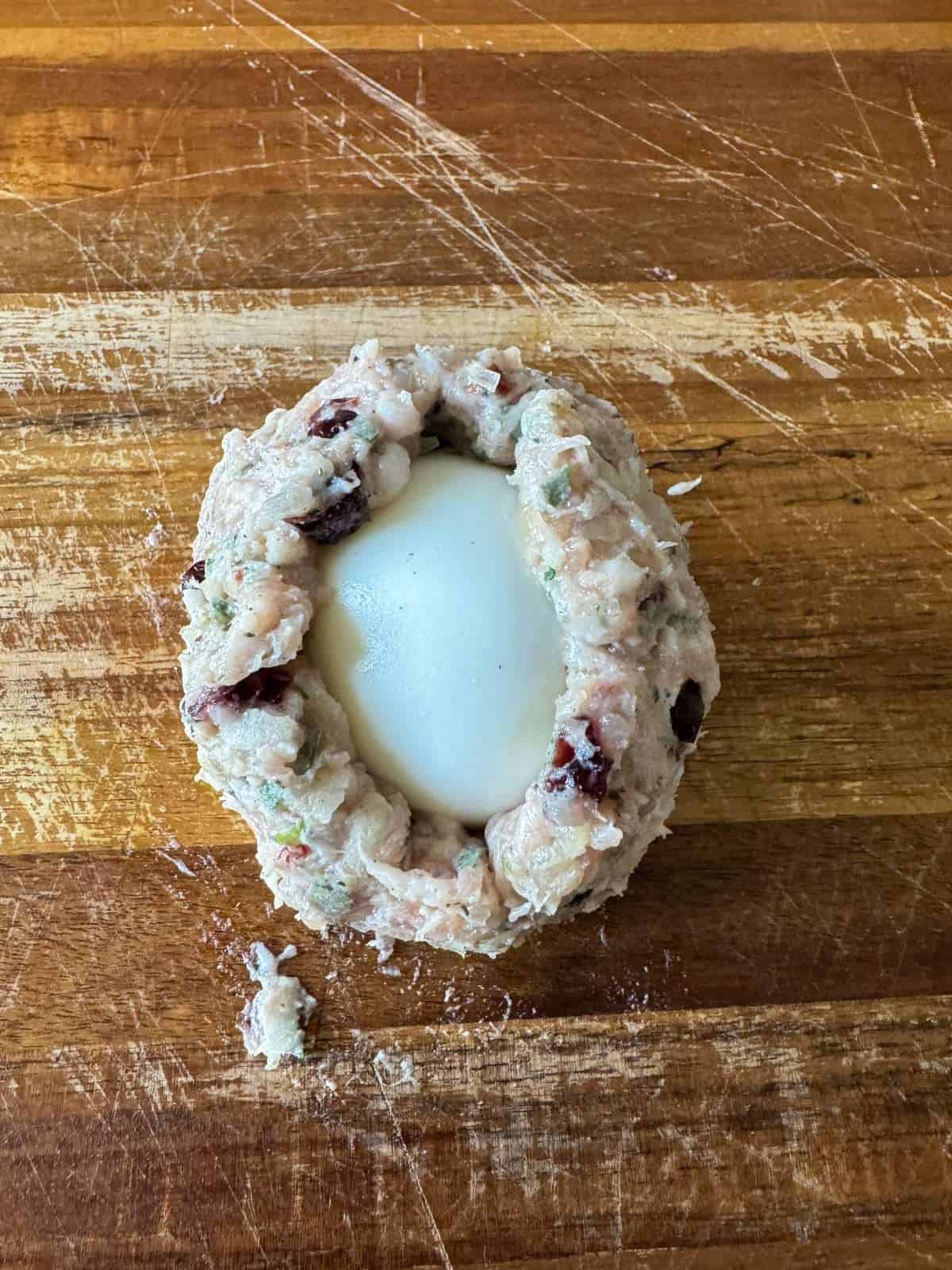
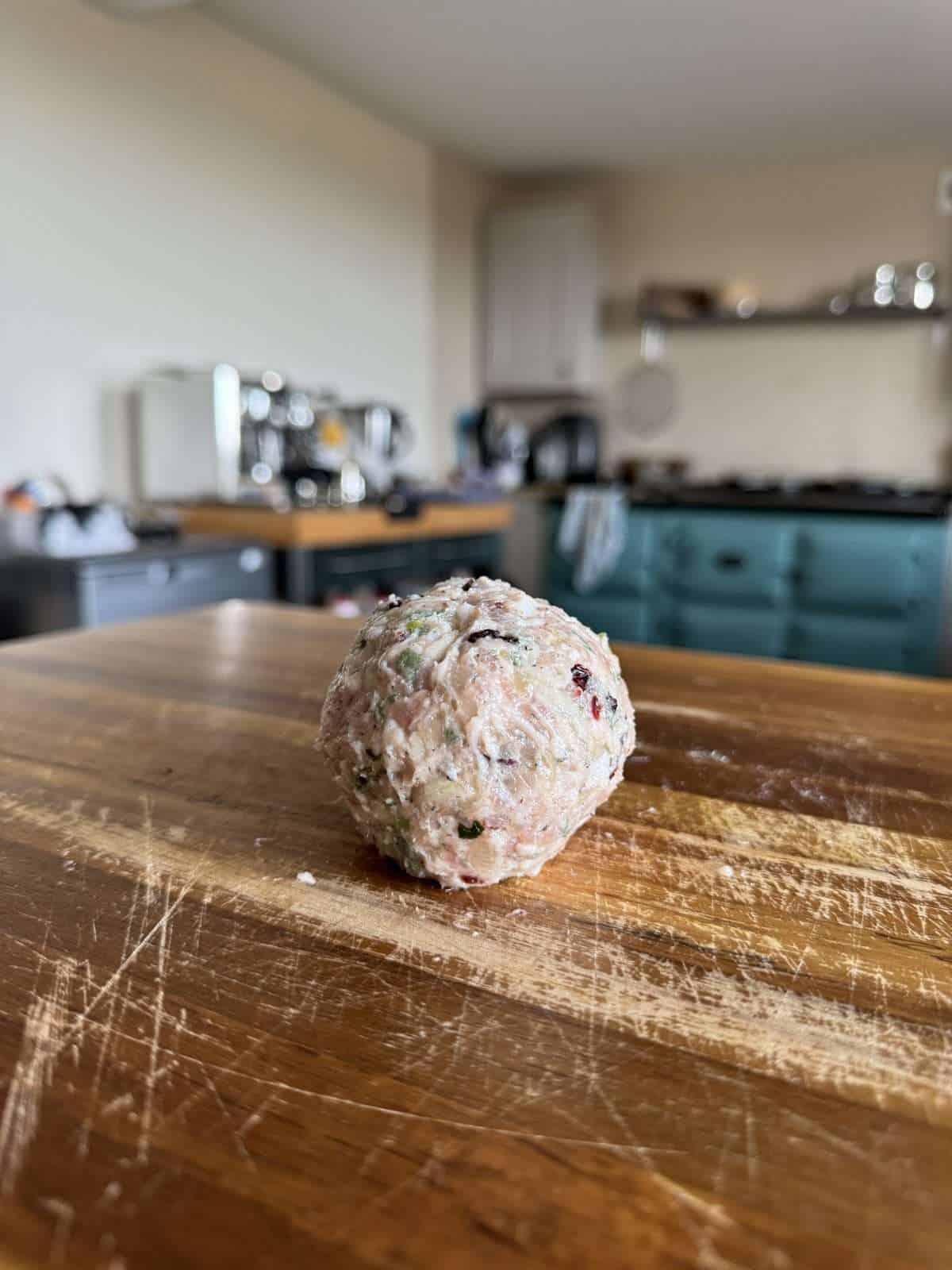
Pané (Bread Crumbing)
Pané – Coating food in flour, eggs & breadcrumbs before cooking.
To pané a scotch egg, we roll it in seasoned flour, dunk in beaten egg then roll in panko breadcrumbs. To ensure an even coating, we then dunk the scotch egg back in the beaten egg then roll in the breadcrumbs again. This is known as a double pané.
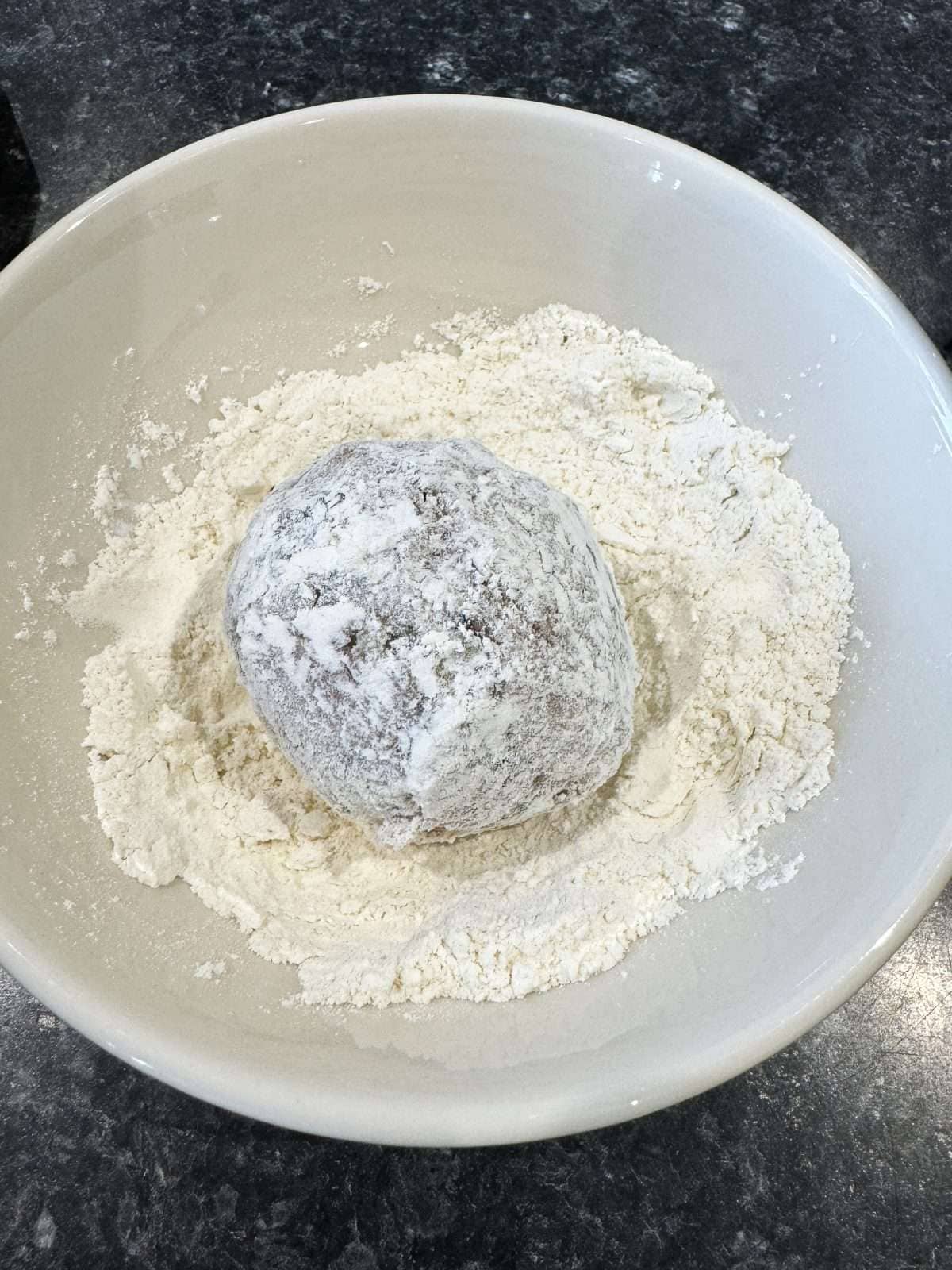
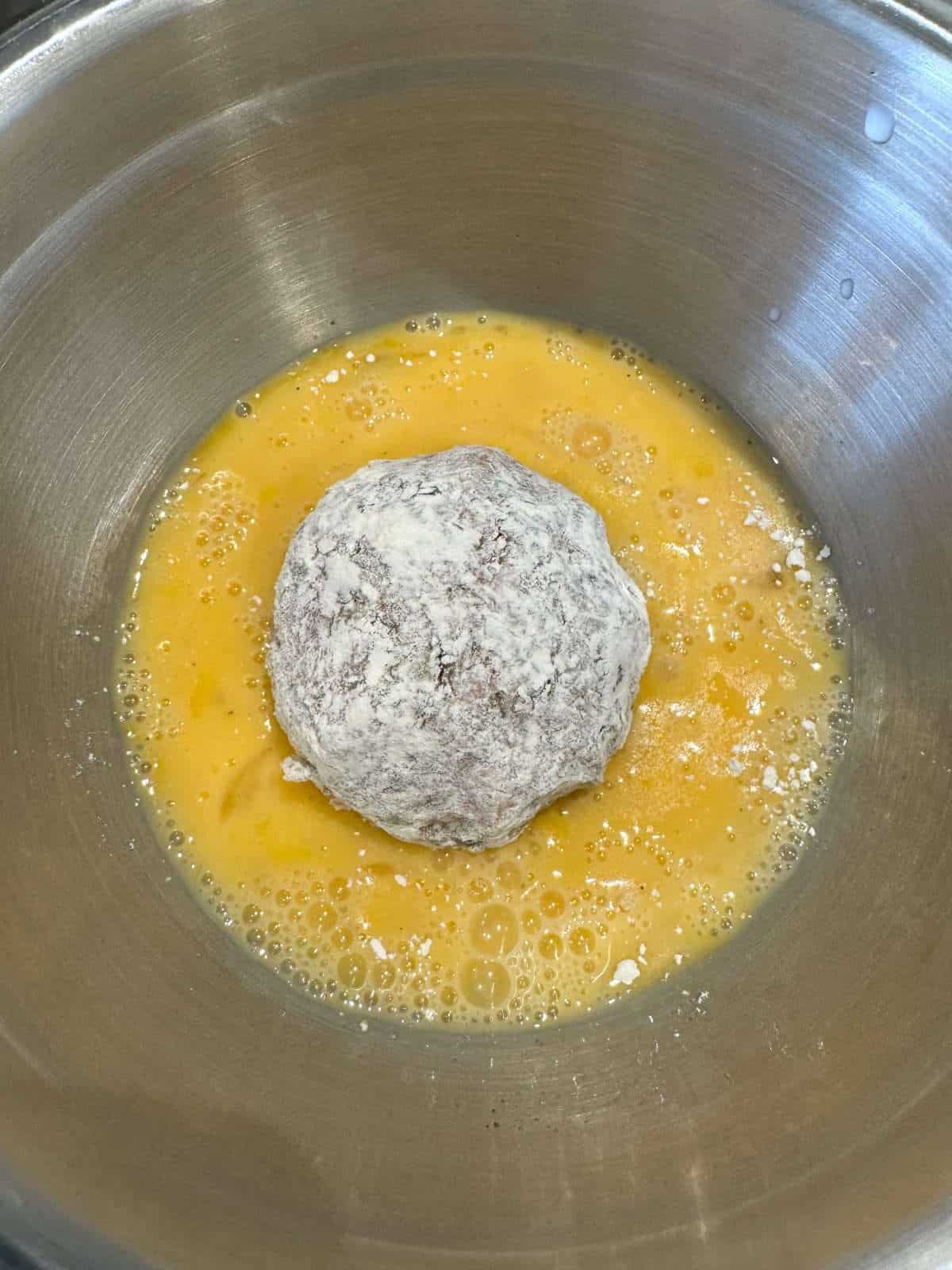
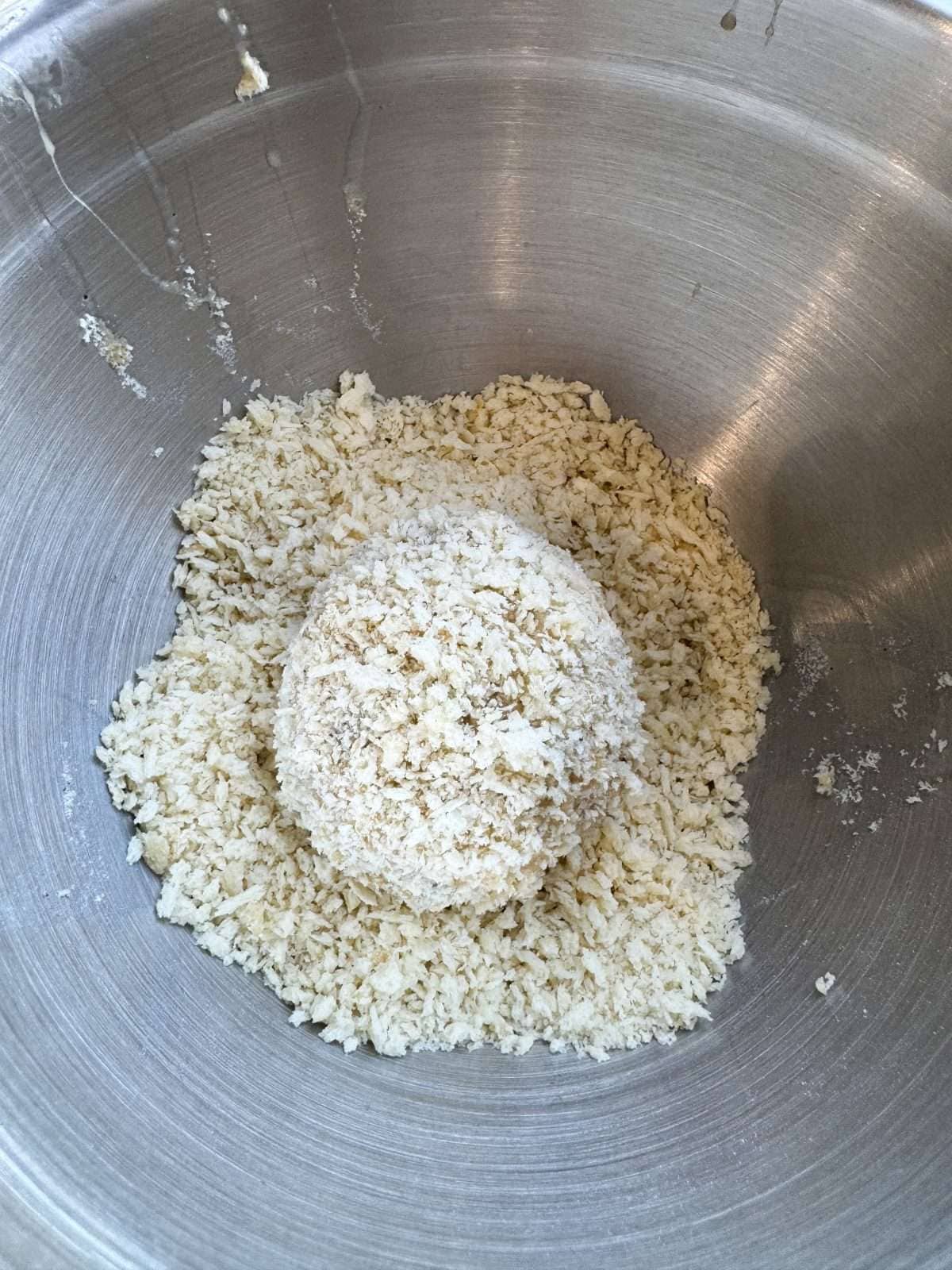
Frying
To cook our scotch eggs, we preheat a deep fat fryer to 160°c/320°f then fry each egg for 8-10 minutes, turning occasionally until the breadcrumbs are a deep golden brown and the sausage meat has reached an internal temperature of 75°c/167°f. You’ll probably need to do this in batches, depending on the size of your fryer.
Once cooked, we transfer the scotch eggs to a plate lined with kitchen paper & let them drain for a minute or two. Then to serve, we cut each egg in half and season the yolks with sea salt & freshly cracked black pepper.
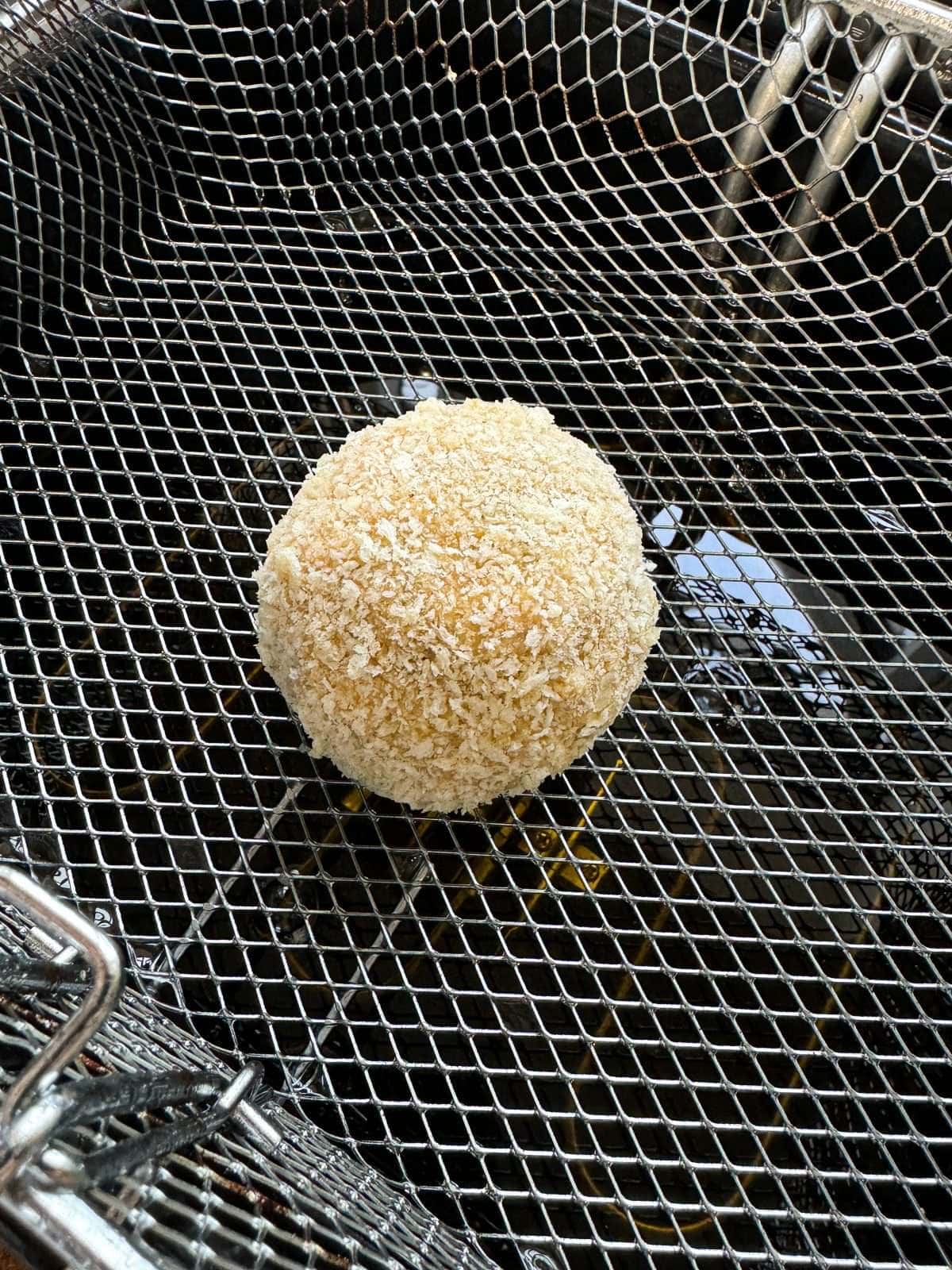
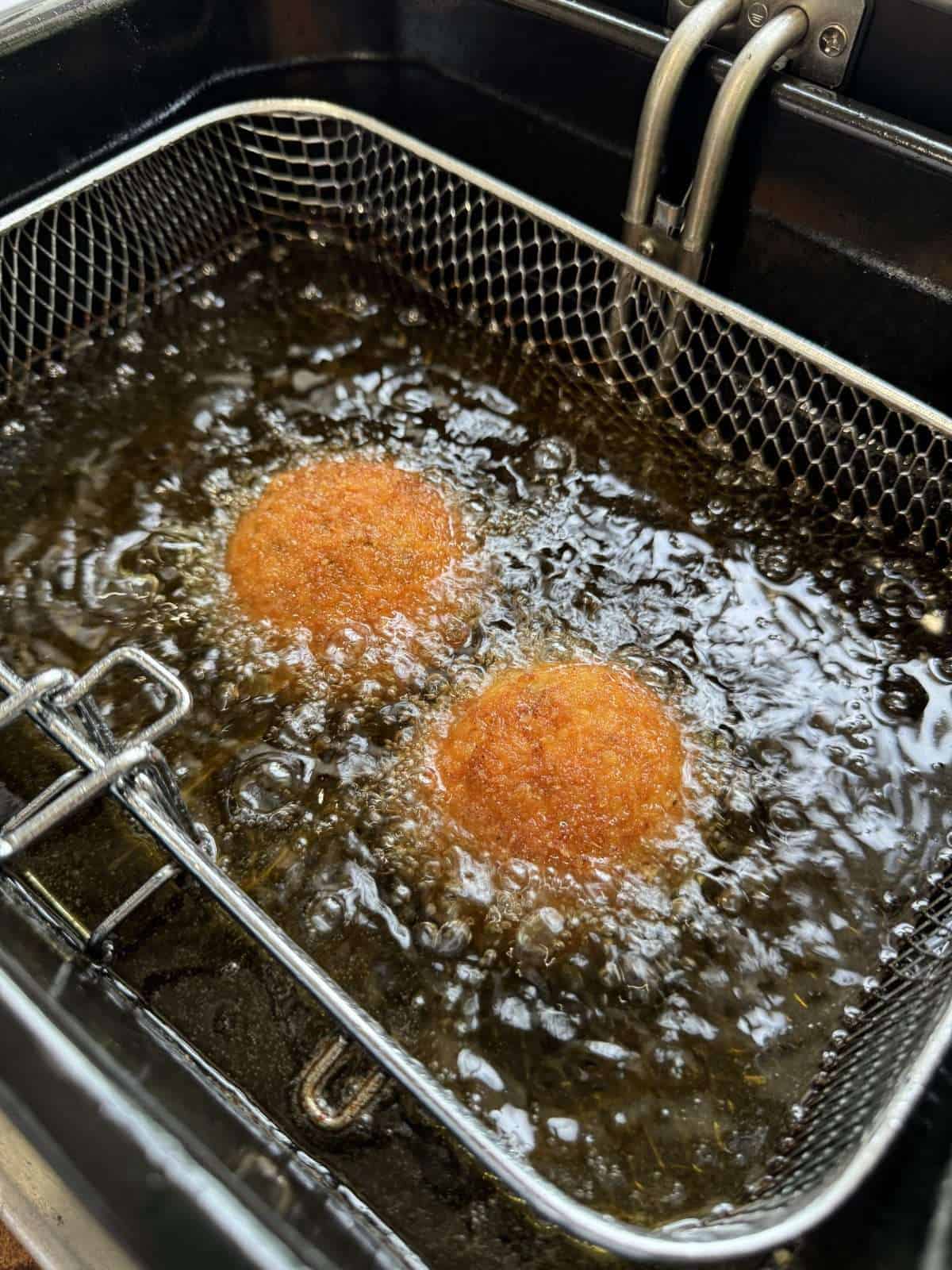
Tips & Tricks
- When cooking the eggs, keep the water at a rolling boil at all times to ensure that they cook properly. Adding a splash of vinegar into the water makes the eggs easier to peel.
- As soon as the eggs are cooked, place them into a bowl of ice & cold water, to stop them cooking immediately.
- Double pané your scotch eggs, for the best coating. Panko breadcrumbs work best here!
- Use a digital food probe to check the internal temperature of the scotch eggs, to avoid overcooking them. Sausage meat is cooked once it reaches 75°c/167°f.
- To serve, cut the scotch eggs in half then season the yolks with sea salt & freshly cracked black pepper.
What To Serve With Christmas Scotch Eggs
Scotch eggs are best served with sauces, chutneys, pickles & salad. To keep things festive, I like to serve these Christmas scotch eggs with some of my Christmas cranberry chutney but they’re also good with English mustard!
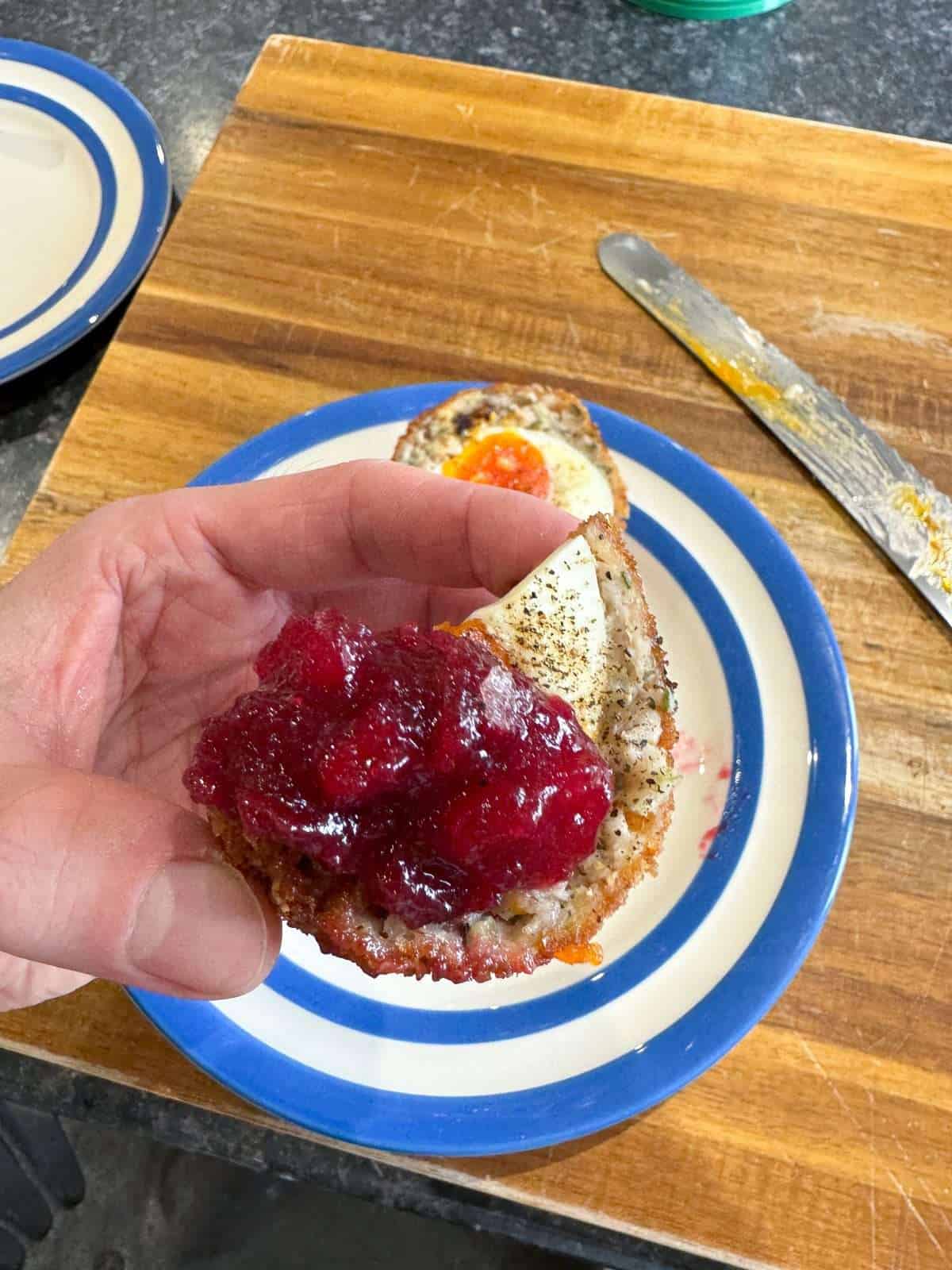
Frequently Asked Questions
Panko breadcrumbs work best for scotch eggs, as they will give them the crispiest coating once fried! Panko are a Japanese breadcrumb, made from dried white bread & are available in most supermarkets.
To make scotch eggs with runny yolks, we need to boil the eggs for 6½ minutes (or 7 minutes, for jammy yolks). The key here is to keep the water at a rolling boil at all times then refresh the eggs in ice cold water as soon as they are cooked.
Yes, for the best results you’ll need to use a deep fat fryer to cook scotch eggs. However, if you don’t have one, you can heat a pan of oil up on the stove. Make sure to do this really carefully though!
The best way to check that your scotch eggs are cooked, is by using a digital food probe. Once cooked, the sausage meat will have reached an internal temperature of 75°c/167°f. The breadcrumbs on the outside should be crisp & golden.
Equipment Used
Please note that these are affiliate links & I may make a small commission if you make a purchase using these links, at no extra cost to you. For more information, click here.
More Christmas Recipes To Try!
- Christmas Cranberry Chutney
- Chicken Liver Mousse With Cider Jelly
- Leftover Turkey & Ham Slab Pie
- Sausage Roll Wreath With Honey Glazed Camembert
- Deep Fried Camembert
- Leftover Turkey Caesar Salad
If you have enjoyed this Christmas scotch egg recipe, it would mean a lot if you could leave a review & rating. And if you’d like to stay up to date with future recipes, follow us on Instagram & TikTok!
Sage & Onion Christmas Scotch Eggs
Equipment
- Deep Fat Fryer
- Digital Food Probe
- Mixing Bowls
Ingredients
Sage & Onion Sausage Meat
- 1 tbsp Vegetable Oil
- 1 Brown Onion (Finely Diced)
- 400 g Sausage Meat
- 1 Granny Smith Apple (Grated – No Need To Peel)
- 40 g Dried Cranberries (Roughly Chopped)
- 2 tsp Finely Chopped Sage
- 1 tsp Finely Chopped Thyme
Soft Boiled Eggs
- 6 Large Eggs (At Room Temperature)
- 1 tbsp White Wine Vinegar
- A Bowl Of Ice Water
To Pané
- 150 g Panko Breadcrumbs
- 40 g Plain Flour
- 3 Eggs
- 1 tbsp Milk
Instructions
Sage & Onion Sausage Meat
- First, add the veg oil into a small saucepan then set it over a medium heat & leave to heat up for a minute or two. Once hot, add in the diced onion & a pinch of salt then cook until soft. This will take 5 minutes or so.
- Once cooked, transfer the onions to a bowl & leave to cool completely.
- Next, add the sausage meat into a mixing bowl with the onions, grated apple, dried cranberries & chopped herbs. Season the meat with salt & pepper then mix well, to combine.
- Cook a small amount of the sausage meat in a frying pan then give it a taste to check the seasoning. Add in more salt & pepper as needed then chill the sausage meat in the fridge until needed.
Soft Boiled Eggs
- Fill a large saucepan with water then add in the vinegar. Cover the pan with a lid, set over a high heat then bring the water to a rolling boil.
- Carefully add the eggs into the boiling water then cook for 7 minutes, making sure that the water is at a rolling boil at all times.If you like a runnier egg yolk, boil the eggs for 6½ minutes.
- Once cooked, immediately add the eggs into a bowl of ice & cold water then leave to cool completely.
- Once the eggs are cool, carefully peel them & place onto a plate lined with kitchen paper.
Scotch Eggs
- Take the sausage meat out of the fridge & portion into 6 equally sized balls. Each should weigh around 90 grams.
- Next, flatten a portion of sausage meat into a 5mm thick disc, place an egg in the middle then mould the meat around it, to form a smooth ball. Repeat with the remaining sausage meat & eggs then chill in the fridge for 30 minutes.
- To prepare the pané station, take 3 bowls, fill one with the breadcrumbs, one with the flour & the other with the eggs & milk. Beat the eggs with a fork then season each bowl with salt & pepper.
- To pané, first roll a scotch egg in the flour then dip into the beaten egg & roll in the breadcrumbs. Now, roll the scotch egg back in the beaten egg & then the breadcrumbs (double pané).
- Place the breadcrumbed scotch egg onto a tray then repeat the pané process with the remaining scotch eggs.
- Once all your scotch eggs have been breadcrumbed, place them in the fridge until you're ready to cook them.
Cooking
- Preheat a deep fat fryer to 160°c/320°f.
- To cook the scotch eggs, fry them in the hot oil for 8-10 minutes, flipping over occasionally until the breadcrumbs are crisp & golden and the meat has reached an internal temperature of 75°c/167°f.You might need to cook the scotch eggs in batches, depending on the size of your fryer. The scotch eggs can be kept warm in an oven between batches or served straight away.
- Once cooked, transfer the scotch eggs to a plate lined with kitchen paper then leave to drain for a minute.
- To serve, slice each scotch egg in half then season the yolk with sea salt & freshly cracked black pepper.

